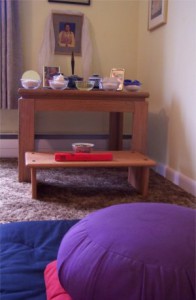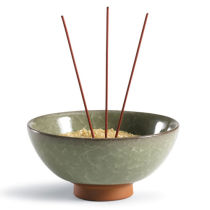Tuesday
Community ArticlesSetting up a Home Shrine
 COLUMN: Good Practice
COLUMN: Good Practice
by Sumner Bradley, long time employee at Samadhi Cushions
To begin with, if you don’t have a shrine, that’s fine. You want to have a space that’s clean, uncluttered, and uplifted. Having dirty socks or old magazines lying around is a distraction and a weight on the mind. It’s the visual equivalent of having the radio on while practicing. But I remember doing a weekthun at Shambhala Mountain Center in 1990 and there was no shrine. Where a shrine might have been was a flower arrangement.
In terms of cleaning, though, I should mention a trap I often fall into which is the thought that I can’t practice until I’ve cleaned. And then two hours later, I’ve done some great cleaning but am still circling the cushion. Your practice area should be clean, the bathroom can be done later.
Editor’s Note: We are currently on hiatus from publishing new articles; in the meantime, please enjoy this classic item reprinted from our back issues.
Worth mentioning, probably repeatedly, is that you will almost never find everything you will want for a shrine all at once. Putting a shrine together is generally a work in progress. It will likely be a while before you have everything you want on the shrine, and often people will replace the items on their shrine long after it is all together. If you find, say, a new offering bowl that you like better than the ones you have, it can be a nice refresher for the shrine. But if you’re starting out with a photo with a stick of incense on the top of a bookcase, that’s fine. A small table, or even a shelf on the wall with offering bowls and candles on it and photos on the wall, and an incense below, will work. You work with what you have, in the space that you have. And then you make improvements.
The first thing you do most likely will not be to go get some lumber and paint and plate glass to build a custom shrine box in your house. (Though for some people that might be just the thing to do.) More likely you’ll start with a photo of a thankga, and/or of teachers, a couple of candles, and grow from there. To me, the basic shrine logic is that there are representatives of sacred world, of enlightened mind: thangkas, pictures of thangkas, photos of teachers, a dharma text, maybe a crystal ball. And there are offerings to that: light from candles, pleasing scent from incense, clear pure water, etc. So there’s a sense of opening to, making yourself available to, awakened mind.
A word about that plate glass, especially if the shrine is covered with cloth. Obviously the glass is easier to clean, and you are more or less bound to get spills out of offering bowls, wax dripping from candles, ash from incense, and so on. With all the things burning on the shrine, the glass is going to be a much safer surface. Especially if you have cats or small children. Though in that case, the high shelf on the wall might be a better option anyway.
 Similarly, what makes an incense burner an incense burner and not just a bowl with sand in it is that the bowl is raised up a bit: it either has a little foot on the bottom or little tripod legs. This is so that if you are burning charcoal in the bowl, the heat of the charcoal is kept away from the surface the bowl is sitting on.
Similarly, what makes an incense burner an incense burner and not just a bowl with sand in it is that the bowl is raised up a bit: it either has a little foot on the bottom or little tripod legs. This is so that if you are burning charcoal in the bowl, the heat of the charcoal is kept away from the surface the bowl is sitting on.
There are many directions you can go in with offering bowls. There are metal ones which you will most likely never break, though they will take polishing to keep them looking fresh. And they are made for the purpose, which is a factor for some people, who are not comfortable using bowls which were designed for juice or sake or tea or soy sauce or soup or candy or dessert. But there are some very nice bowls which clearly had their genesis with food in mind but which look lovely on a shrine.
Candles are fairly straightforward. Votives generally are more economical and less likely to be knocked over than tapers, and if your shrine is small, tapers will probably overwhelm the other things on it. However, votives burn better if they are burning for a longer period of time, say 45 minutes or an hour at least. If you only burn candles for 10 or 15 minutes at a time, tapers will burn better. There also are pillar candles which will last a long time but again are best burned only for long sessions.
There are little things you can get like a tray to go under the incense burner and catch stray ash, or little dishes to hold matches.
Your shrine is a representative of sacred world, of enlightened mind, in your home. There is generally a sense of formality and ceremony in relating to it. Which among other things helps create a good container for practice. However that works for you. I had a housemate during my Naropa years who when she started sitting, the first thing she got was a gong. Having a shrine to sit in front of wasn’t so important to her, but having the ceremonial punctuation of beginning and ending her practice session with the gong gave it a clear structure.
In the same way, photos of teachers that go on a shrine are generally better if they are formal portraits. At the same time, you want pictures that are meaningful to you, that are going to inspire and encourage your practice. A home shrine is always going to have some balance between the formality of it and your own aesthetic choices.
Flowers are always good to go on a shrine. Which brings me back to that sense that the shrine is never complete, since there is always something else that can be offered.
~~
Have Good Practice tips for us? We would love to hear from you about your tips for good practice! Please send any tips you would like to share to Ani Dawa Chotso, our Good Practice column editor.
















